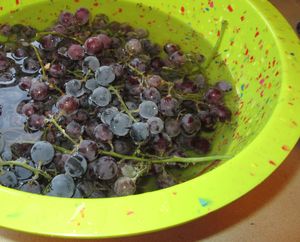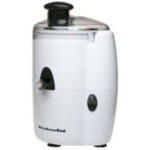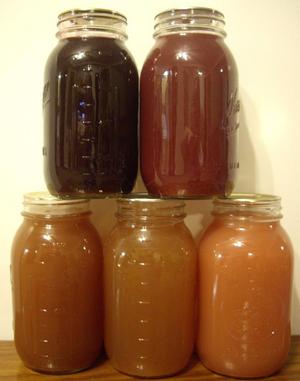If you have access to wild grapes, making your own juice from scratch is a rewarding experience. Not only is homemade grape juice more delicious than “processed” grape juice concentrates, homemade means that you control both the flavor and the sweetness of the juice. Up until several years ago, I made my homemade juice by straining boiled grapes through a clean pillowcase which was a long and tedious process. Ever since purchasing a steam juicer, I can now put up 20 gallons of juice in just a couple of days.
Steam juicers are a special type of equipment designed to extract juice from produce using steam. In the old days, steam juicers used to be made of speckled enamelware. Modern juicers are now made of stainless steel though a few low-cost aluminum models have recently hit the market. No matter what type of steam juicer you have, they all are used exactly the same way to make grape juice.
Here is how it’s done:
1. Gather your materials first. The steamer juicer should have a base (for water), a central reservoir for the juice, a sieve that rests either in or above the juice reservoir, a lid, a plastic tube which should be attached to a tiny spigot in the juice reservoir, and a clamp for pinching the tube closed. If any of these parts are missing, you won’t be able to make juice. Other materials should include pot holders and containers for decanting the juice.
2. Fill the base with several inches of water. Set on the stove top and bring water to boiling. In the meanwhile, wash the grapes and pick through for leaves, large twigs, and debris.
3. Pack the grapes loosely in the strainer.
4. Assemble the steam juicer by placing the strainer over the juice reservoir, and the juice reservoir over the boiling water. Pinch the drainage tube “closed.” Cover the grapes with the lid. When the water reaches a full boil, turn back the heat to a medium setting.
5. Watch. Depending on the volume of grapes in the sieve, it can take anywhere from 10 to 20 minutes to extract the juice. The best way to tell when all the juice has been extracted is to lift up the lid and examine the grapes. If the grapes are still plump, then more steaming is necessary. If the grapes have flattened out to where all that’s left is the skins and the seeds, the steaming is done.
6. Decant. The hot juice can then be decanted into proper containers. For freezing, one quart canning jars work great providing you leave about an inch of expansion space. Home canners might prefer decanting the hot juice directly into pint or quart canning jars which can be processed immediately.
To serve up your homemade grape juice, experiment by diluting it down with a bit of water or even adding some sugar for sweetener. One popular way of serving up grape juice at parties is to cut the juice with equal amounts of Ginger Ale for a sparkling grape juice that both kids and adults will enjoy.






